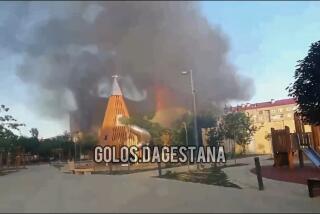Riots Killed 31 in Azerbaijan City, Tass Says
- Share via
MOSCOW — The official Soviet news agency Tass said Friday that 31 people were killed last weekend in ethnic rioting in the Azerbaijani city of Sumgait.
The casualty total was Moscow’s first official mention of a death toll in the communal unrest that has rocked the Transcaucasia regions of Azerbaijan and Armenia for the last two weeks, leaving the city of Sumgait under curfew and military and special civilian volunteers patrolling the streets of at least one other major Azerbaijani city.
The Tass report seemed significant in the light of the obvious consternation displayed in recent days by Soviet authorities in Moscow, who acknowledged the unrest in the area but have been slow to report casualty figures or to discuss events leading up to the violence in Sumgait.
The death toll report, which filtered slowly though a bureaucracy unaccustomed to dealing frankly with the internal problems of the Soviet Union, seemed to suggest that the policy of glasnost , or openness, espoused by Soviet leader Mikhail S. Gorbachev did finally prevail.
The Tass report blamed “hooligan elements” for provoking the unrest, adding that “wavering, immature people . . . fell under the impact of false rumors concerning the developments in Nagorno-Karabakh.”
Victims of the violence, Tass said, included members of various nationalities, among them elderly men and women.
Reports from the area, in the southeastern region of the Soviet Union, have been sketchy, and the district has been closed to foreign journalists.
The unrest began two weeks ago with demonstrations in the Armenian capital of Yerevan, where Armenians took to the streets to demand that Nagorno-Karabakh, an enclave of Azerbaijan, be joined to the Soviet Republic of Armenia.
The Armenians, who are mainly Christian and dominate Nagorno-Karabakh’s population, complain that they are faced with discrimination by the heavily Muslim population of Azerbaijan.
Soviet officials, as well as sources from the region, have said that the cities in the area--Sumgait as well as Kirovabad, where police and civilian patrols were reported to be keeping the peace--are now quiet, although tensions have remained high.
Solution Promised
Gorbachev himself has intervened in the conflict, reportedly promising to find a solution. He has also been reported as telling Armenian officials that they had undermined his reform program by taking to the streets with demonstrations rather than making their appeals though more discreet channels.
It is not at all clear how Gorbachev might resolve the dispute, and speculation is widespread that the Soviet leader might have been more prudent to keep out of a dispute that hard-liners in the Soviet Communist Party may blame on his policy of openness. That policy, his internal critics believe, has given more encouragement for the airing of long-suppressed grievances and disputes from the Soviet Union’s scores of national minorities.
Some of those grievances, a senior Western diplomat noted Friday, were potentially more serious than the disturbances in Azerbaijan and Armenia, since a number of them, particularly in the Baltic republics, involve major differences with the Soviet government.
The demonstrations, beginning with Yerevan, involved numbers that are apparently unprecedented in modern Soviet history. Some sources say that as many as a million people were involved, and even conservative estimates say that several hundred thousand demonstrators joined a march that remained peaceful.
Clashes Erupted
However, it was apparently in the aftermath of that march, as word of it spread though the cities of Azerbaijan and Armenia, that violent clashes erupted, causing a widespread fear on the part of minority populations in both areas and, in some cases, a panicked exodus to friendly territory.
Reports from the area say that, at least for several days, schools were closed and factories were shut down. The city of Sumgait is one of the most heavily industrialized areas of Azerbaijan. Much of Armenia is considered to be highly prosperous by Soviet standards.
Although reports from the region suggested calm, it was not easy to tell how much force had been employed to ensure its continuation. Foreign Ministry spokesman Gennady I. Gerasimov said Thursday that “decisive measures” had been taken but declined to describe them in detail.
More to Read
Sign up for Essential California
The most important California stories and recommendations in your inbox every morning.
You may occasionally receive promotional content from the Los Angeles Times.












